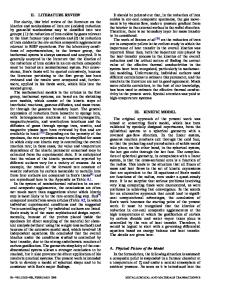Reduction of Iron-Oxide-Carbon Composites: Part II. Rates of Reduction of Composite Pellets in a Rotary Hearth Furnace S
- PDF / 928,452 Bytes
- 13 Pages / 593.972 x 792 pts Page_size
- 47 Downloads / 322 Views
ODUCTION
THE rotary hearth furnace (RHF) is a donut-shaped refractory-lined reactor that makes use of waste oxides, particulate fines, and millscale generated in the steel mills and that produces direct-reduced iron (DRI), by mixing the oxides with a carbonaceous reductant such as coal into a composite. The composite material is usually charged into the RHF (hearth) in the form of pellets[1,2] or as a powder mixture.[3] The temperature and atmosphere inside the furnace are controlled by means of burners positioned along the walls and, sometimes, along the roof of the furnace. The energy for reduction is principally due to the thermal radiation from the furnace walls and roof and from the burner flames. It is known that the heat-transport phenomenon limits the productivity of the RHF. Most of the RHFs typically use a single layer or, at most, two layers of composite S. HALDER, formerly Graduate Student, Department of Materials Science and Engineering, Carnegie Mellon University, is with Praxair Technology Center, Praxair Inc., Tonawanda, NY 14150. Contact e-mail: [email protected] R.J. FRUEHAN, Professor, is with the Department of Materials Science and Engineering, Carnegie Mellon University, Pittsburgh, PA 15213. Manuscript submitted April 28, 2008. Article published online November 11, 2008. 796—VOLUME 39B, DECEMBER 2008
pellets on the hearth. This is because when a multilayer bed is used, the amount of energy reaching the lower layers of the multilayer bed is substantially reduced. A new ironmaking concept is being investigated that involves the combination of an RHF with an iron-bath smelter.[4] The idea is to prereduce the iron oxide to approximately 70 pct metallization in the RHF and carry out the remaining smelting of the DRI obtained from the RHF and gangue removal in the smelter. By doing so, the productivity of the RHF can be increased due to the lower target degree of metallization, and the energy requirements of the smelter will be substantially reduced due to the prereduced feed. Because of the lower target degree of metallization, there exists the possibility that the number of layers of the pellet bed may be increased. Therefore, it is possible to overcome the individual limitations of both of these reactors and enhance the productivity of the overall process. Previously,[5] the reaction-rate constants for the chemical reactions, namely, the carbon gasification by CO2 and the wu¨stite reduction by CO were determined. Two different carbonaceous reductants, coal char and devolatilized wood charcoal, and two kinds of ferric oxide, an artificial highly porous hematite and naturally occurring hematite ore tailings, were the subjects of the investigation for the rate constants. It was found that METALLURGICAL AND MATERIALS TRANSACTIONS B
the rate constants for the carbon oxidation for wood charcoal were almost an order of magnitude higher than coal char because of the highly porous morphology of wood charcoal; the rate constants for the wu¨stite reduction, on the other hand, were found to be higher for
Data Loading...











